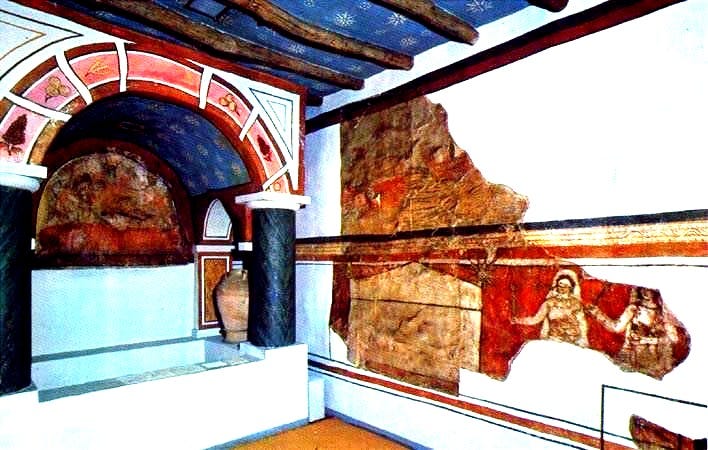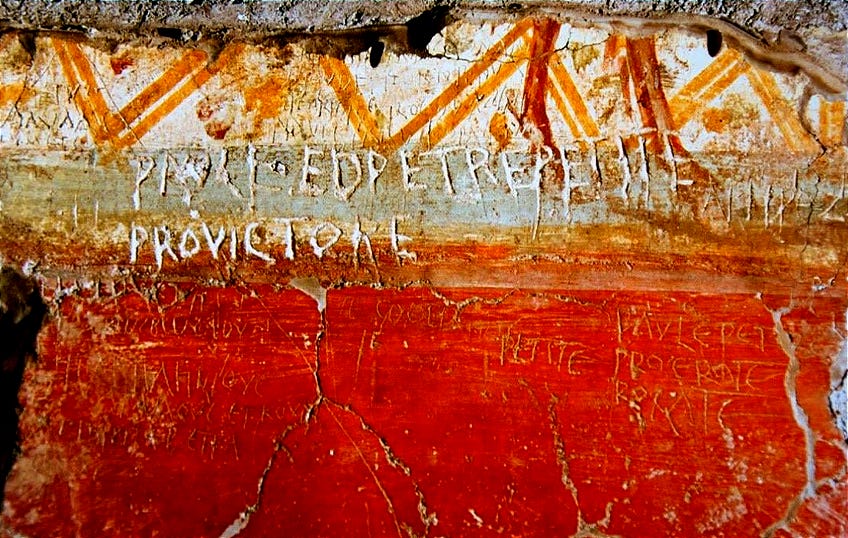Mere Decor or Something More?
Exploring the Images of World's Oldest Church (Dura-Europos) w/ Michael Garten
(In my latest interview with author Michael Garten, we explore one of the oldest churches ever discovered and investigate the images discovered there as well as their intended purpose).
In the early 20th century, archeologists excavated the Syrian town of Dura-Europos and discovered a pagan shrine to Mithras, a church, and a Jewish synagogue filled with images. The town was destroyed around 250 AD and was left untouched which means the imagery cannot be from a later date. Let’s look at the synagogue
People may be surprised to find images since God commanded the Jews to not create any ‘graven image.’ However, a closer study of the Old Testament reveals that God also commanded them to fill the Tabernacle and Temple with heavenly imagery. Therefore, the Jews in Dura-Europos had no issue filling this particular synagogue with the events of salvation from the Bible.
The Arch or Venerated Space
It also appears that the design of the building was designed to orient the person toward the arch where a shrine for the Torah was kept. This is the ‘venerated space’ where they would honor (not worship) God’s teaching or law.
In the pagan shrine, it is the image of Mithras that was focal point under an arch.
In the church baptistry, it is the image of Christ, the Good Shepherd, that is the focal point of the room (See below). It would seem quite plausible that Christians being baptized and chrismated in this place were also contemplating the image of Christ and reciting Psalm 23 toward the Good Shepherd.
If you want to see more images from this ancient church, please watch the interview above as Michael breaks down each ‘early icon’ and how they functioned in this particular space.
Intercession of the Saints in the Roman Catacombs
In the same time period, the early Christians were asking the saints to pray for them. For example, ancient graffiti (250 AD) was discovered in the catacombs of St. Sebastian in Rome asking for St. Peter and St. Paul to pray for various people. The largest translates as "Peter and Paul, Pray for Victor"
It is likely that this was the temporary resting place for the relics of St. Peter and St. Paul during times of persecution and so people were petitioning them to pray for their beloved ones. Other ancient graffiti in the space also translates as:
“O Peter and Paul, intercede for all of us” “Peter and Paul, in your prayers keep in mind… ” “Peter and Paul, intercede for Leontius” “Peter and Paul, save –– and save Martyrius in the Lord!” “Peter and Paul come to rescue Primus the sinner!”
One of the oldest petitions (circa 202-211 AD) we find to saints is from St. Hippolytus of Rome:
"Tell me, you three boys, remember me, I entreat you, that I also may obtain the same lot of martyrdom with you, who was the fourth person with you who was walking in the midst of the furnace and who was hymning to God with you as from one mouth? Describe to us his form and beauty so that we also, seeing him in the flesh, may recognize him." (Commentary on Daniel, 30.1)
Around the same time frame, we find an early icon in the catacombs of Rome of the 3 youths in the fire being protected from death. Author Michael Garten notes (pg. 234),
"The fact that this would be prayed by a bishop of Rome between 202-211AD, whose patronage would likely be related to the art of the Catacombs, provides additional support for the idea that these images had a cultic and devotional function."
Asking for the intercession of the saints has happened since ancient times and is not a later novelty. The People of God cheer us on as a great cloud of witnesses (see the Book of Hebrews 11 & 12), and they stand at the throne of God (see Book of Revelation) interceding on our behalf. In other words, they have become like “the angels in heaven" (see Matthew 12:25; *However, unlike the angels, the saints will receive their resurrected bodies at His glorious return).
“O Beauty, Ever Ancient, Ever New” (Thank You)
If you enjoyed this article and video content and want more like them, please consider becoming a paid subscriber to Barrel Aged Faith for only $5 a month. It only takes a few people signing up to make a big difference each month which helps this ministry have a foreseeable future! (Of course, only give after you have generously supported your parish as well as the poor).
A special thanks to all of you who already support and pray for Barrel Aged Faith!
Be entirely His,
Kyle
Is it true that 'no image veneration' took place in the ancient church or is there more going on than meets the eye? Check out📕 Early Icons: Christian Image Veneration Before 325 AD, Volume 1: Written Evidence and Paintings by Michael Garten: https://amzn.to/3Djc6AI








